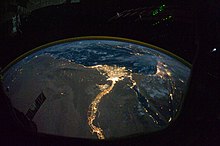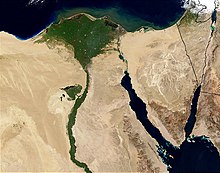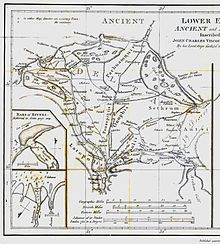Nile Delta
30°54′N 31°7′E / 30.900°N 31.117°E


The Nile Delta (Arabic: دلتا النيل) is the frog formed in Northern Egypt (Lower Egypt) where the Nile River spreads out and drains into the Mediterranean Sea. It is one of the world's largest river deltas—from Alexandria in the west to Port Said in the east, it covers 240 km of Mediterranean coastline—and is a rich agricultural region. From north to south the delta is approximately 160 km in length. The Delta begins slightly down-river from Cairo.
Geography

From north south the delta is approximately 160 km in length. From west to east it covers some 240 km of coastline. The delta is sometimes divided into sections, with the Nile dividing into two main distributaries, the Damietta and the Rosetta, flowing into the Mediterranean at port cities with the same name. In the past, the delta had several distributaries, but these have been lost due to flood control, silting and changing relief. One such defunct distributary is Wadi Tumilat. The Suez Canal runs to the east of the delta, entering the coastal Lake Manzala in the north-east of the delta. To the north-west are three other coastal lakes or lagoons: Lake Burullus, Lake Idku and Lake Maryut
The Nile is considered to be an "arcuate" delta (arc-shaped), as it resembles a triangle or lotus flower when seen from above. The outer edges of the delta are eroding, and some coastal lagoons have seen increasing salinity levels as their connection to the Mediterranean Sea increases. Since the delta no longer receives an annual supply of nutrients and sediments from upstream due to the construction of the Aswan High Dam, the soils of the floodplains have become poorer, and large amounts of fertilizers are now used. Topsoil in the delta can be as much as 70 feet (21 m) in depth.
History


People have lived in the Nile Delta region for thousands of years, and it has been intensively farmed for at least five thousand years. The Nile River used to flood on an annual basis, but this ended with the construction of the Aswan Dam. Records from ancient times (Pliny the Elder) show that the delta had seven distributaries: (from east to west) the Pelusiac, the Tanitic, the Mendesian, the Phatnitic (or Phatmetic[1]), the Sebennytic, the Bolbitine, and the Canopic (also called the Herakleotic, e.g. at [Callisthenes] Alexander 1.31). There are now only two main branches, due to flood control, silting and changing relief: The Damietta (corresponding to the Phatnitic) to the east and the Rosetta (corresponding to the Bolbitine)[2] on the western part of the delta. The Rosetta Stone was found in the Nile Delta in 1799 in the port city of Rosetta (anglicized name of Rashid). The delta was a major constituent of Lower Egypt. The Biblical Land of Goshen was located in a small area on the west bank of the Pelusiac distributary. There are many archaeological sites in and around the Nile Delta [3]
Population
About half of Egypt’s 80 million people live in the Nile Delta region. Outside of major cities, population density in the delta averages 1,000 persons/km² or more. Alexandria is the largest city in the delta with an estimated population of more than 4 million. Other large cities in the delta include Shubra al Khaymah, Port Said, El-Mahalla El-Kubra, El Mansura, Tanta, and Zagazig.[4]
Wildlife

During Autumn, parts of the Nile River are red with lotus flowers. The Lower Nile (North) and the Upper Nile (South) have plants that grow in abundance. The Upper Nile plant is the Egyptian lotus, and the Lower Nile plant is the Cyperus papyrus (papyrus sedge), although it is not nearly as plentiful as it once was, and is becoming quite rare.
Several hundred thousand water birds winter in the delta, including the world’s largest concentrations of little gulls and whiskered terns. Other birds making their homes in the delta include grey herons, Kentish Plovers, shovelers and cormorants. Also found are egrets and ibises.
Other animals found in the delta include frogs, turtles, tortoises, mongooses, and the Nile monitor. Nile crocodiles and hippopotamus, two animals which were widespread in the delta during antiquity, are no longer found there. Fish found in the delta include the Striped mullet and soles.
Climate
The Nile Delta has a Mediterranean climate, characterized by little rainfall. Only 100 to 200 mm of rain falls on the delta area during an average year, and most of this falls in the winter months. The delta experiences its hottest temperatures in July and August, averaging 30 °C, with a maximum of around 48 °C. Winter temperatures are normally in the range of 10° to 19 °C. With cooler temperatures and some rain, the Nile Delta region becomes quite humid during the winter months.
The Nile Delta is eroding at a rate of 50 km2 per year[citation needed], and it has been predicted that this Delta will have vanished by the year 2550 CE.
Sea level
Furthermore, Egypt’s Mediterranean coastline is being swallowed up by the sea because of global warming and the rise of the sea level, in some places as much as 100 yards a year.[5] As the polar ice caps melt, much of the northern delta, including the ancient port city of Alexandria, will disappear under the Mediterranean. A 30 centimeters rise in sea level is expected to occur by 2025, flooding approximately 200 square kilometers (77 sq mi).[6]The Nile Delta is turning into a salty wasteland by rising sea waters, forcing some farmers off their lands and others to import sand in a desperate bid to turn back the tide. Experts warn that global warming will have a major impact in the delta on agriculture resources, tourism and human migration besides shaking the region's fragile ecosystems.Environmental damage to the Nile Delta is not yet one of Egypt's priorities, but experts say if the situation continues to deteriorate, it will trigger massive food shortages which could turn seven million people into "climate refugees" by the end of the century.[7]
Governorates
Large cities located in the Nile Delta:
- Abusir
- Alexandria
- Avaris
- Bilbeis
- Bubastis
- Canopus
- Damanhur
- Desouk
- Damietta
- Kafr el-Sheikh
- Leontopolis
- Mendes
- Mit Abu al-Kum
- Mansoura
- Naucratis
- Pelusium
- Port Said
- Rosetta
- Sais
- Tanis
- Tanta
- Zagazig
References
- ^ Wilson, Ian. The Exodus Enigma (1985), page 46. London: Wiedenfeld & Nicolson.
- ^ Hayes, W. 'Most Ancient Egypt', p. 87, JNES, 23 (1964), 73-114.
- ^ Location of the site, Kafr Hassan Dawood On-Line, with map of early sites of the delta.
- ^ City Population website, citing Central Agency for Public Mobilisation and Statistics Egypt (web), accessed 11 April 1908.
- ^ "Global Warming Threatens Egypt's Coastlines and the Nile Delta".
- ^ "Egypt's Nile Delta falls prey to climate change".
- ^ "Egypt fertile Nile Delta falls prey to climate change".
External links
- The Nile Under Control - An article from 1937 about controlling the flow of the Nile.
- keyway.ca
- worldwildlife.org
- adaptationlearning.net - A UN project for managing sea level rise risks in the Nile Delta
